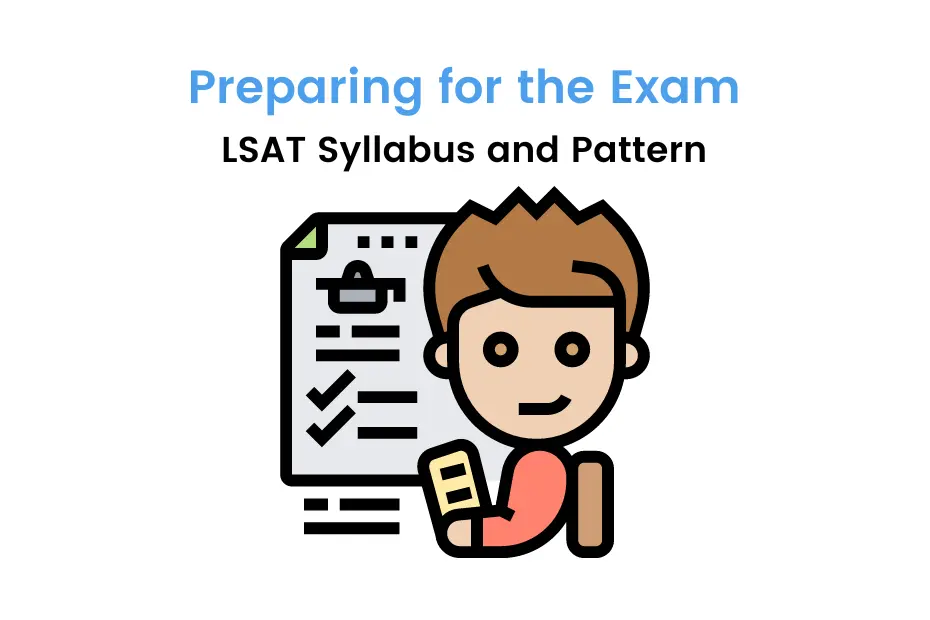The LSAT is an important exam for people who want to enroll in some of the law schools in India for undergraduate and postgraduate courses. To perform well in the LSAT exam and get into a top law school, you need to understand what’s on the LSAT. The LSAT syllabus covers a lot of different topics and question types, so it’s important to know what you’ll be facing during the exam.
The LSAT syllabus covers a variety of topics scattered throughout different sections of the LSAT exam. These topics have some of the questions that test your skills and quality. This quality assurance helps the colleges to check the readiness of the students for the different undergraduate and postgraduate law courses.
If you’re aiming to become a law student and take the LSAT, you need to prepare carefully for each of the sections. Understanding the LSAT syllabus inside and out will help you feel more confident when you take the test and give you the skills you need to succeed in law school. In this exploration of the LSAT syllabus, we’ll break down each section and provide valuable tips and guidance to help you navigate this important step on your journey to becoming a lawyer.
Topics covered
Complete Overview of the LSAT Syllabus
The LSAC, Law School Admission Council sets the syllabus for the LSAT India exam. Because of the COVID-19 pandemic, LSAT India is now conducted online instead of using paper and pen. Because of this change, they have also made adjustments to the LSAT India syllabus. One significant change is that they removed the ‘Variable’ section because it doesn’t work well with the new online format. The remotely proctored LSAT India will now have about 92 questions divided mainly into sections:
- Analytical Reasoning
- Logical Reasoning (divided into two sections)
- Reading Comprehension
A clearer picture of the LSAT syllabus overview can be assessed by the information given below:
| Exam Name | LSAT-India |
| Conducting Body | Law School Admission Council or LSAC |
| Exam Mode | Online (remotely proctored using the AI-enabled technology) |
| Medium of the Exam | English |
| Question Type | Multiple-Choice Questions |
| Full Marks | On a scale of 420 and 480 |
| Time Duration | 240 minutes |
| Official Website | https://www.lsatindia.in/ |
For complete details regarding the eligibility and exam dates, please refer to our blog LSAT Exam.
Suggested Blog: Top LSAT Colleges in India
LSAT Exam Pattern 2024
The LSAT India is a test that checks how good you are at critical thinking, and it does this by asking you three different types of multiple-choice questions. While you have already seen the three main sections of the LSAT exam, it is time for you to study the LSAT exam pattern. The exam pattern, consisting of the topics, number of questions, and the duration are as follows:
| Section Type | Number of Questions | Duration |
| Analytical Reasoning | 23 | 35 minutes |
| Logical Reasoning (1) | 22 | 35 minutes |
| Logical Reasoning (2) | 23 | 35 minutes |
| Reading Comprehension | 24 | 35 minutes |
| Total | 92 | 2 hours 20 minutes |
Do you know why LLB in India is considered to be one of the top options? Read more to find out!
LSAT Syllabus: Subject-Wise Weightage
The students should get a general idea of the three sections in the LSAT India exam. This will help them know what subjects and skills they need to focus on to do well in each section and get a good overall score. In this section, we will be discussing the detailed breakdown of the LSAT syllabus. They are as follows:
LSAT Syllabus: Analytical Reasoning
According to the LSAT India syllabus, the Analytical Reasoning part tests how well you can use your analytical abilities to understand different statements and make a decision based on them. If you’re good at this section, it probably means you’re really good at solving problems.
Some of the important topics in the analytical reasoning section of the LSAT syllabus are mentioned below.
| Arrangements | Coding & Decoding |
| Comparisons | Directions |
| Family-based Problems | Intersection-type Questions |
| Logical Deductions | Selections |
LSAT Syllabus: Logical Reasoning
In the domain of law, it’s important to be able to make strong and logical arguments. That’s why this section evaluates how well test-takers can think logically. The Logical Reasoning part includes questions where you have to use your logical thinking skills to arrive at a conclusion. These questions are based on short arguments that involve legal reasoning.
Some of the important topics in the logical reasoning section of the LSAT syllabus are mentioned below.
| Binary Logic | Blood Relations |
| Calendars | Clocks |
| Cubes | Logical Connectives |
| Logical Matching | Logical Sequence |
| Number and Letter Series | Seating Arrangements |
| Syllogism | Venn Diagrams |
LSAT Syllabus: Reading Composition
Another important thing when you’re preparing for a career in law is good reading skills. The LSAT Reading Comprehension part is designed to see if test-takers can read and understand long and complicated texts. It also checks how well they understand English and their vocabulary.
Students can expect passages in the reading comprehension from some of the following sectors:
| Business | Economics |
| Law | Literature |
| Philosophy | Psychology |
| Sociology | Technology |
Looking for the Law Courses after 12th? Read the blog to get a complete list of the courses.
Important Tips for LSAT Exam Preparation
Now that you have an idea of the exam pattern and the detailed LSAT syllabus, we should be looking at the tips & tricks for excelling in these sections. Here are some important tips to help you prepare for the LSAT exam in the sections of Analytical Reasoning, Logical Reasoning, and Reading Comprehension:
Tips for Analytical Reasoning
Some of the important tips and tricks that will help you perform well in this section are mentioned below:
- Comprehending the Types: Understand the various kinds of puzzles or games you’ll encounter in this section, like arranging items in order, grouping them, or matching them. Knowing these types will help you come up with specific strategies.
- Consistent Practice: Solve as many puzzle questions as you can. The more you practice, the better you’ll get at spotting patterns and making quick deductions.
- Making Visuals like Diagrams: Draw diagrams to show the relationships and rules in the puzzles. Clear drawings can make tricky situations easier to understand.
- Managing the Time: Work on getting faster at solving puzzles while still being accurate. Time yourself during practice to get used to the real test’s time constraints.
Tips for Logical Reasoning
Some of the important tips and tricks that will help you perform well in this section are mentioned below:
- Understand Arguments: Learn how arguments are put together, including the reasons people give and the conclusions they draw. Figure out what’s strong and weak in these arguments.
- Use Real LSAT Questions: Practice with official LSAT materials for this section. These questions are similar to what you’ll see on the actual test.
- Predict Answers: Try to guess the right answer before you look at your options. This can save time and help you avoid wrong answers.
- Eliminate Wrong Answers: Sometimes, it’s easier to find and get rid of the incorrect answer choices rather than picking the perfect one.
Tips for Reading Comprehension
Some of the important tips and tricks that will help you perform well in this section are mentioned below:
- Read Actively: When you read passages, pay close attention and take notes on the main ideas, important details, and what the author is trying to say. Stay engaged with the text.
- Manage Your Time: Decide how much time you’ll spend reading and answering questions for each passage. Stick to this plan so you have enough time for all of them.
- Look at Structure: Understand how passages are organized, like how they start and develop their ideas. Watch for transition words and the main points.
- Improve Your Vocabulary: Work on learning more words to help you understand the text better. Be ready to make educated guesses based on what you read.
- Review Your Mistakes: After you practice, go over the questions you got wrong. Figure out why you missed them and learn from your errors.
By following these tips, you can get better at the different parts of the LSAT syllabus and boost your chances of doing well on the exam.
Also, LSAT is an online exam, you must know important tips for online entrance exams.
Time’s Up!
Understanding the LSAT syllabus is important if you want to become a lawyer. This syllabus is carefully designed and covers critical thinking, logical reasoning, and analytical skills, which are crucial for a successful legal career. It includes tricky puzzles, reasoning problems, and reading comprehension tasks, all of which prepare you for the challenges lawyers face.
As the field of law keeps changing, the LSAT syllabus remains a reliable way to see if someone is cut out for law school. To do well in this tough test and get into a good law school, you need to work on each section, get better at it, and become a skilled legal thinker.
Looking for expert guidance in choosing the right course and college after the 11th and 12th? Look no further than iDreamCareer! Our comprehensive career guidance product provides personalized insights, aptitude assessments, and expert counseling to help you make informed decisions. With our in-depth knowledge of experts, you can select the right course and college. Our experts will assist you in selecting the perfect path for your future.
Waste no time! Embark on your journey towards a fulfilling career by accessing iDreamCareer’s College Selection Program today. Take that pivotal first stride toward transforming your interior design dreams into reality!
Useful Link
LSAT Syllabus: FAQs
The LSAT syllabus consists of three main sections: Logical Reasoning, Analytical Reasoning (Logic Games), and Reading Comprehension. These sections assess critical thinking, logical reasoning, and reading skills, which are essential for success in law school.
The difficulty of LSAT India can vary from person to person. It is considered a challenging exam because it tests complex skills like critical thinking and logical reasoning. However, with dedicated preparation and practice, many students have achieved excellent results.
Cracking LSAT India depends on your preparation and commitment. While it may be challenging, with focused study and practice using official LSAT materials, many candidates have been able to achieve competitive scores and secure admission to top law schools.
The adequacy of a 2-month LSAT preparation period depends on your starting point and how much time you can dedicate to studying each day. With consistent effort, it is possible to make significant progress in two months, but a longer preparation period may provide more comprehensive readiness. It’s important to create a study schedule and stick to it to make the most of your time.
A student can appear for the LSAT exam for about seven times in a lifetime. However, the scores can be sent to the colleges multiple times.

Sushant, an accomplished content writer at iDreamCareer, has dedicated his life to the pursuit of writing since childhood. Having earned his education at the prestigious University of Delhi, he possesses a profound understanding of both arts and science in the field of education. Leveraging his professional experience, Sushant brings a fresh perspective to analyzing emerging trends in the realms of writing and education. His youthful mindset, coupled with a positive outlook, is geared towards enlightening students through the impactful delivery of wisdom and knowledge.


















